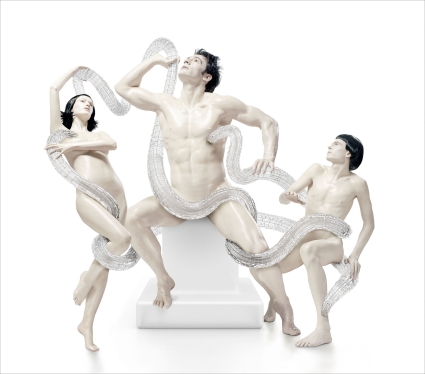Michael Najjar’s creative process is based on current scientific ideas in the field of genetic engineering. He uses these which great artistic freedom to visualise new visual worlds in which fact, fiction and pure fantasy tumble and interweave. The resulting images can be chilling representations, fascinating interpretations or imaginative guesswork. The forthcoming exhibition will include eight series, all dating from the 1997-2008 period but all at first sight quite different in concept and execution. The earliest is entitled ¡viva fidel! – journey into absurdity and could easily be taken for a traditional black-and-white photo-documentary on Cuba. However, the digital manipulation that permeates the images casts doubt on the truth of the photographic account. In the years since then, Najjar has chopped and changed ‘reality’ ever more heavily. In his latest series, bionic angel, the process goes so far that the viewer wonders what if any role photography has played in generating such sophisticated, almost otherworldly, images. But these too are photographs, created with the use of flesh-and-blood models and the help of a team of stylists, make-up artists, lighting specialists and image manipulators.
Michael Najjar (b. Landau, 1966) can be regarded as a pioneer in the digital manipulation of photographic images. He himself calls his work ‘hybrid photography’: a new visual idiom created by the marriage of analogue and digital technology. Advances in technology have created new opportunities for manipulation which are increasingly casting doubt on the authenticity of images and make it essential always to question their ‘truth’. In his information and apocalypse series (2003), therefore, Najjar investigates the extent to which the concept of photographic truth now has any meaning at all in times of war and ideological struggle. For netropolis, on which he worked from 2004 to 2006, Najjar went to the tops of the highest towers in twelve major world cities (including Tokyo, New York, Mexico City, Dubai and Shanghai) and took photographs of the city facing all four points of the compass. He then used an ingenious logarithmic program to superimpose the resulting images. The result is a series of optical illusions, which Najjar sees as expressing the increasing complexity of our urban infrastructure.
Taken together, these series reveal that the leitmotiv of Michael Najjar’s oeuvre is the dramatic moment of metamorphosis, the technology-driven transformation now taking place both in individuals and in society as a whole. He does not necessarily consider processes in the field of genetic engineering and cosmetic manipulation in ethical terms, but merely regards them as a logical future development.
